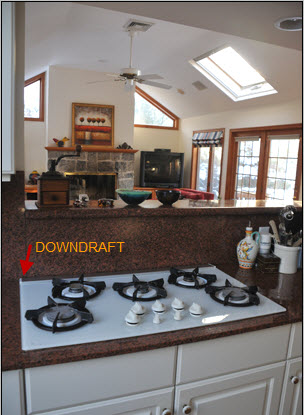I've been meaning to talk about the downdraft behind the cooktop, positioned in a peninsula which separates the living area beyond. The higher than normal ledge behind the cooktop and downdraft serves somewhat of a purpose, if only to disguise the carnage in the kitchen.
But, my real message today, is that, in my VERY experienced opinion, downdrafts suck, but not in the, um, physical way of drawing in moisture, fumes, odors and various other solid particulates produced by cooking, whether cooking in a heavy OR light manner. I forgot about the downdraft in a kitchen I owned many years ago, before I became a kitchen designer. At the time, I worked WITH a kitchen designer, who, as I remember clearly, never had the conversation with me about downdrafts vs. updraft hoods. What can I say? I was young and naive as well. And the range was against a wall, which should be a no brainer for a conventional hood and conventional advice! I remember, then, the trick of tilting pot and pan lids so that the fumes would move toward the downdraft far more effectively than just turning on the downdraft, even on high.
So, fast forward to my new home and my new (old) downdraft. Let me just simply say this. I would never, and do never, recommend a downdraft as being equal in performance to a range hood. There is, in my opinion, an enormous difference in performance. Of course, yes, much depends on the conventional hood's specs and proximity to the cooktop, but, when a hood is designed properly, the performance comparision between a downdraft and a hood against a wall is night and day in favor of the hood.
I can tell you first hand, the visible fumes and light smoke, even when the downdraft is on high, do not reach the downdraft. Well, maybe some fumes do, but my guess is over half of the cooking extracts do NOT get removed. What happens instead is that much of the fumes move into surrounding areas of the kitchen, or in my case, perhaps the great room beyond, settling into one's hard and soft furnishings.
Rather than making this post full of statistics and design specifications, I'm making it anecdotal (with a professional's knowledge of course!) If you have a choice, don't use a downdraft if you can avoid it. Mine is a high end cooktop/downdraft. The brand doesn't matter, because they all perform the same way. And yes, my downdraft rises about 7" above the countertop surface. Doesn't matter.
Very simply....try to choose a hood against the wall rather than a downdraft situated anywhere. A hood above an island or peninsula as opposed to a downdraft? That does not make much of a difference, as surrounding air currents interfere with the cooking extracts on their way up toward the hood. Either way, in this scenario, you're scr.....d. :( If you:
a. want the toxins out of your home as quickly as possible
b. want the odors out, as opposed to lingering odors
c. want the smoke and moisture out
d. do not want residue on your hard and soft surfaces
then, you will feel like this, I guarantee it! :)


